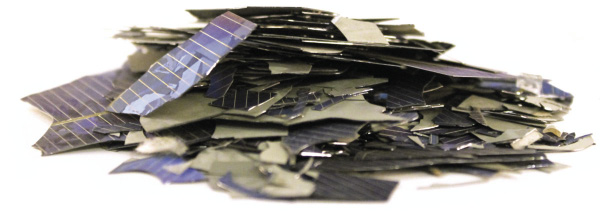A new report proposes making solar panel producers (instead of end owners) accountable for India’s PV waste. It states such a policy approach would help the nation tackle its PV waste better than the scenario whereby a landfill ban is introduced, but the end-owner retains end-of-life management responsibility.
The report titled “PV Waste Management in India” was prepared as part of an EU-India technical cooperation project on renewable energy and energy efficiency in India, with the support of the Ministry of New and Renewable Energy (MNRE). Industry bodies The National Solar Energy Federation of India and SolarPower Europe, along with European take-back and recycling association PV Cycle, contributed to the report.
The report makes recommendations based on experience with the extended producer responsibility (EPR) policy approaches for PV modules in several European countries.
Currently, PV modules and inverters aren’t covered by the Indian E-Waste (Management and Handling) Rules as these rules apply only to (i) information technology and telecommunication equipment and (ii) consumer electrical and electronics product categories. Neither PV modules nor inverters are listed among these identified electrical and electronic equipment categories.
The report recommends creating an EPR legislation for PV modules in India separately from the E-Waste Rules. Such a law could set the producers’ responsibility for PV modules and – where required – other PV system products, such as inverters and batteries, it stated.
The EPR legislation framework could include collective PV module waste management by creating an organization run by the industry.
The report authors surveyed Indian stakeholders (especially manufacturers and developers) on different PV waste management mechanisms. The survey found that almost 80% of the respondent manufacturers were willing to take PV end-of-life responsibility. A majority of stakeholders agreed that a fee be paid at the time of purchase by the owner of the PV modules to finance the end-of-life management of PV modules.
Further, the stakeholders are willing to create a fund that is managed by an industry body.
Landfill ban on PV modules, control and monitoring by the State Pollution Control Boards and/or the Ministry of Environment/Renewable Energy through the industry organization or the individual producer, and regular reporting on the sold amounts of PV modules and on the amounts of waste PV modules collected are among the other components proposed under the EPR framework.
Mounting waste
The report stated that PV waste generation in India is currently insignificant considering that solar PV modules generally last 30 years or longer and the nation installed only 570,000 tonnes of PV modules before the end of 2016. The vast majority of PV modules – 2,175,000 tonnes – was installed in the period 2017-19.
While end-of-life (EoL) modules will constitute PV waste’s main source only in the early 2040s, early failures or damages during transportation, installation, and operation contribute to the current mass of PV waste. The study estimated these volumes under three growth scenarios of the Indian PV market. It found that by the year 2030, India will generate a cumulative PV module waste of 11 kilotonnes (kt) in the Low scenario, 21 kt in the Medium scenario, and 34 kt in the High scenario.
Here, the Low and Medium scenarios forecast a 9-18 GW of annual installations in the next five years. Annual installations increase significantly in the mid and long term, reaching 22-46 GW by 2030.
Conversely, the High scenario assumes that national government objectives are reached due to a surge of installed capacity in 2021 and 2022. After peaking in 2024, annual installations decline to 17 GW in 2030.
Under the Low and Medium scenarios, cumulative capacity reaches 187 and 287 GW, respectively, up from 40 GW in 2020. The High scenario capacity reaches 400 GW by 2030, in line with government ambition. Assuming that PV systems installed in 2020-2030 have a lifetime of at least 30 years, any capacity installed during this period will reach the end-of-life stage not before 2050.
This content is protected by copyright and may not be reused. If you want to cooperate with us and would like to reuse some of our content, please contact: editors@pv-magazine.com.









2 comments
By submitting this form you agree to pv magazine using your data for the purposes of publishing your comment.
Your personal data will only be disclosed or otherwise transmitted to third parties for the purposes of spam filtering or if this is necessary for technical maintenance of the website. Any other transfer to third parties will not take place unless this is justified on the basis of applicable data protection regulations or if pv magazine is legally obliged to do so.
You may revoke this consent at any time with effect for the future, in which case your personal data will be deleted immediately. Otherwise, your data will be deleted if pv magazine has processed your request or the purpose of data storage is fulfilled.
Further information on data privacy can be found in our Data Protection Policy.